Here is a blast from the past, a rave from the grave when I first got into survivalism, by heck things have changed  In the US the primary magazines were the LIVE FREE newsletter followed by the American Survival Guide.
In the US the primary magazines were the LIVE FREE newsletter followed by the American Survival Guide.
https://www.bbc.com/future/article/...illing-magazine-for-nuclear-doomsday-preppers
In the 1980s, you could buy a publication offering detailed advice about how to prepare for nuclear war – it makes for timely, fascinating and occasionally morbid reading.
I
If you were to browse a British newsstand in the early 1980s, you might have discovered a rather unusual magazine.
Called Protect & Survive Monthly or “PSM”, it aimed to teach people how to survive the almost unthinkable – nuclear war.
“How many citizens would know what to do to protect their own lives and loved ones?,” wrote editor Colin Bruce Sibley in the maiden issue. And how many, he asked, would look dumbfounded to the skies, “waiting for a ‘convenient’ bomb to explode above their head and blast them into eternity?”
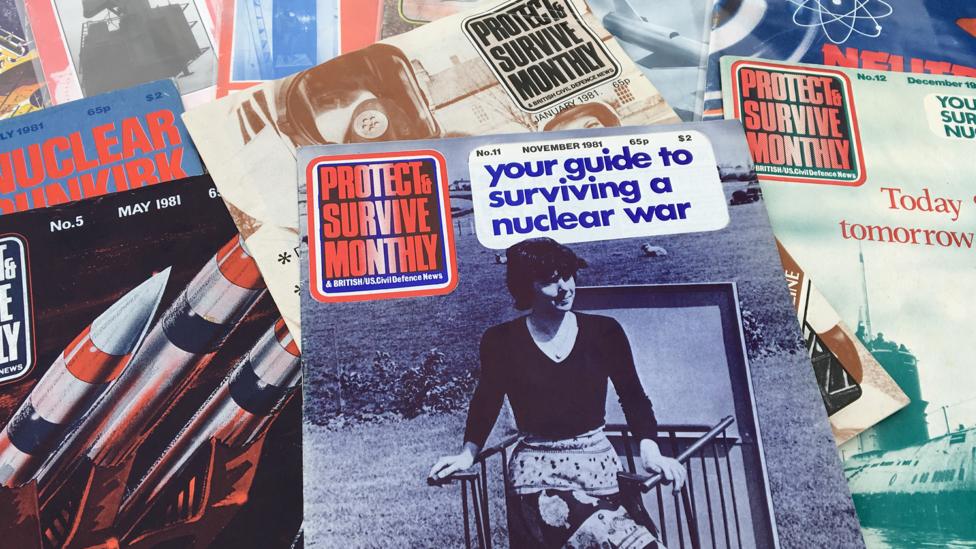
Building shelters was a common theme in the magazine - alongside vermin control (Credit: Javier Hirschfeld)
PSM’s name referenced a contemporaneous, but unconnected, government information campaign (Protect and Survive) to teach British citizens the basics of survival during nuclear Armageddon. The pamphlets and videos distributed by authorities are famous – but the similarly titled independent magazine has faded into obscurity.
In light of the nuclear threats coming out of the US and North Korea in recent weeks, reading the magazine in 2017 is an intriguing but chilling experience, including topics such as nuclear shelter contruction, the burial of loved ones, cannibalism, and even the difficulties of dealing with packs of wild rats.
READ MORE
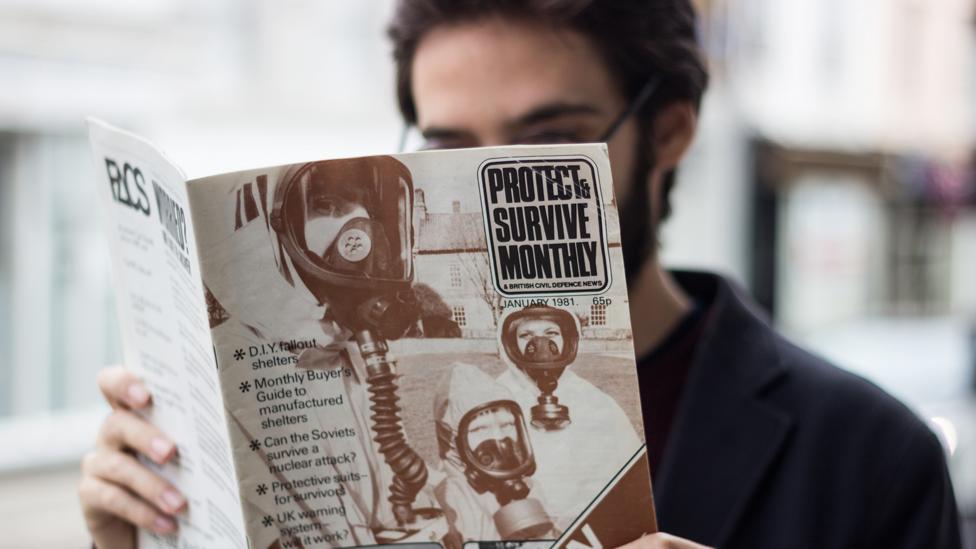
One family staged an experiment for the magazine to see if they could live in a shelter for an extended period (Credit: Javier Hirschfeld)
The magazine’s issues, many of which are retained at the British Library in London, present a very clear picture of what its makers thought the future looked like. A family dressed in protective suits and gas masks, outside an English country house, was featured on the cover of the first edition. A later issue showed a happy mother tending her baby – in a fallout shelter. And another presented huge missiles waiting to be launched somewhere in the middle of decimated nuclear waste. The surroundings are red and black. On the horizon, a mushroom cloud glows.
The sense that nuclear war wasn’t just a possibility, but practically imminent, is everywhere in the magazine. In the conclusion to that first editorial, editor Sibley writes, “if shelters are built now and Civil Defence techniques are learnt thoroughly, the aftermath death toll can be minimised” – as though the bombs were expected any moment.
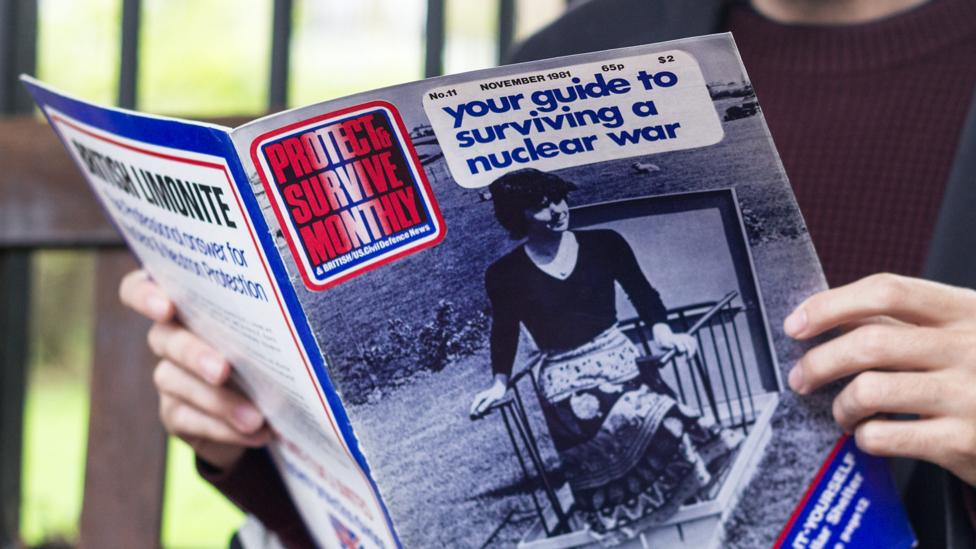
Protect and Survive Monthly was published in the early 1980s (Credit: Javier Hirshfeld)
What, then, needed to be done? More than anything, there was an obsession over acquiring or building a fallout shelter for your home. Every edition of PSM featured reams of advertisements from British and international companies offering to construct such a shelter, or send one that could be buried in your garden and accessed through a small hatch.
A long-running feature of the magazine also told DIY-enthusiasts how to build their own. Fine details, such as the radiation shielding effectiveness of various materials, were included. Every 18mm (0.7in) of steel cut the radiation dose in half, one article explained, but you’d need 71mm (2.8in) of brickwork to achieve the same protection.
PSM once reported on a Cornish family’s two week experimental stay in their own fallout shelter – cut off from the outside world, role-playing a new life after the annihilation of civilisation. Robert and Margaret Farmer, along with their 11 year-old daughter Sarah, emerged triumphantly at the end of the experiment, which PSM described as a “complete success”. It did record, however, that “Sarah was a little bored around day three”.
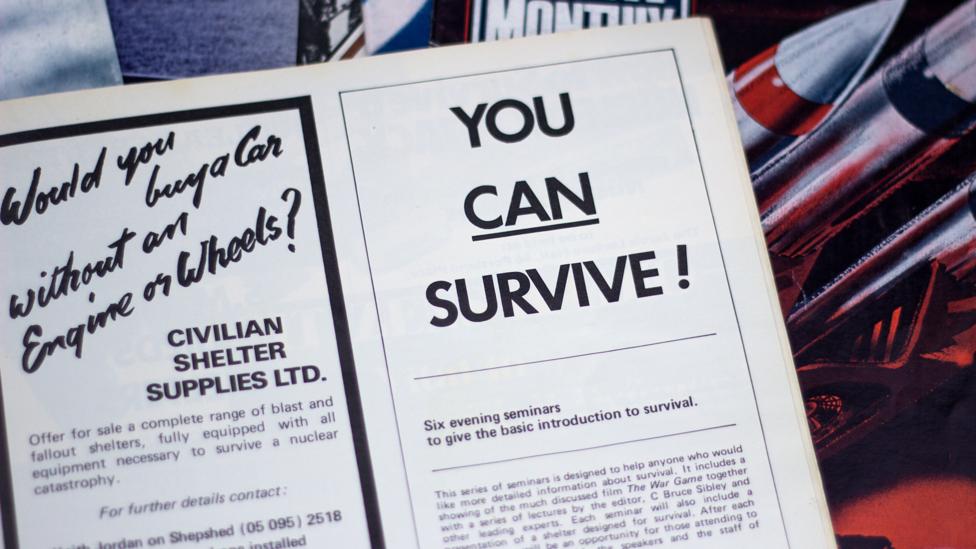
Advertisements in the magazine included shelter-builders, seminars and even wine clubs (Credit: Javier Hirschfeld)
The magazine also kept track of projects up and down the country to erect refuges. A Welsh dairy farmer was reported to have spent the equivalent of £60,000 ($78,000) in today’s money on a safe haven for himself and his family. His next plan was to build a fallout shelter for his cows.
One advert even promoted a wine club, with vintages you could keep in your shelter
Many ingenious ideas were put forward – Tony Oldham, editor of British Caver magazine, suggested your local cave could make a handy refuge. Clean water might be collected as it dripped from stalactites, he explained.
Wherever readers planned to hide out, their safe space needed be stocked with useful items such as tools, fuel, first aid kits and Geiger counters, PSM advised. A month’s supply of food was also desirable. One advert even promoted a wine club, with vintages you could keep in your shelter. As one article put it, “You don’t want to be caught in a queue at the supermarket when the bomb drops!”
It was also important to acquire protective suits with gas masks that could reduce contamination from fallout – radioactive particles that spread into the environment after a nuclear detonation.
As the myriad options available were explained to readers each month, there were also regular referrals to the civil defence procedures that had been set up in other countries, including the Soviet Union, Sweden and Switzerland. PSM expressed a particular envy for the Swiss, 90% of whom, one issue claimed, had “immediate access” to a fallout shelter.
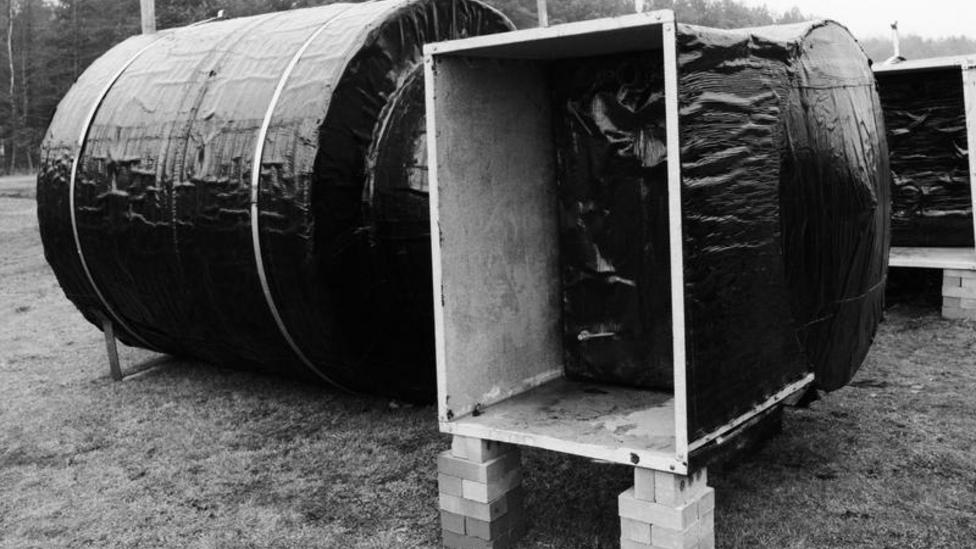
A shelter designed and built by the UK Home Office at the Home Defence College in York in 1980 (Credit: Imperial War Museum)
While it may seem to some as though the survivalists of the early 1980s were getting carried away with their provisions, recently declassified documents suggest a wide-scale nuclear war was closer at that time than perhaps any other. Encouraging the public to take the threat seriously might not have been so outlandish after all.
“It was a time of real threat,” explains John Preston at the University of East London, who has studied civil defence materials from the 1980s. “The superpowers were very much on a trigger.
“People were aware and worried about the threat of nuclear war – all the opinion surveys show that people thought it was a real possibility,” he adds.
I remember I had a fascination with it. My dad was obsessed with the idea of civil protection – Max Tookey, PSM reader
One PSM reader who still remembers the mood of the time is Max Tookey, now a lecturer in psychology at the University of Brighton. Aged 16, he wrote a letter to PSM that read, “Hastings, like a lot of towns in the South East, has a number of caves, old mines, and railway tunnels; why can’t local county councils convert these into mass shelters for the population?”
“I remember I had a fascination with it,” he recalls today. “My dad was obsessed with the idea of civil protection.”
As a teenager, Tookey had watched films like When the Wind Blows – an animated feature about an elderly British couple who survive the outbreak of nuclear war.
“If I remember rightly, with my school friends, we talked about what could happen quite a lot actually and this got me fired up,” he says.
Tookey, like many, still thinks that civil defence is neglected. He retains his old enthusiasm for caves being converted into fallout shelters – he suggests Chislehurst Caves in Kent, which were used as air raid shelters during World War Two.
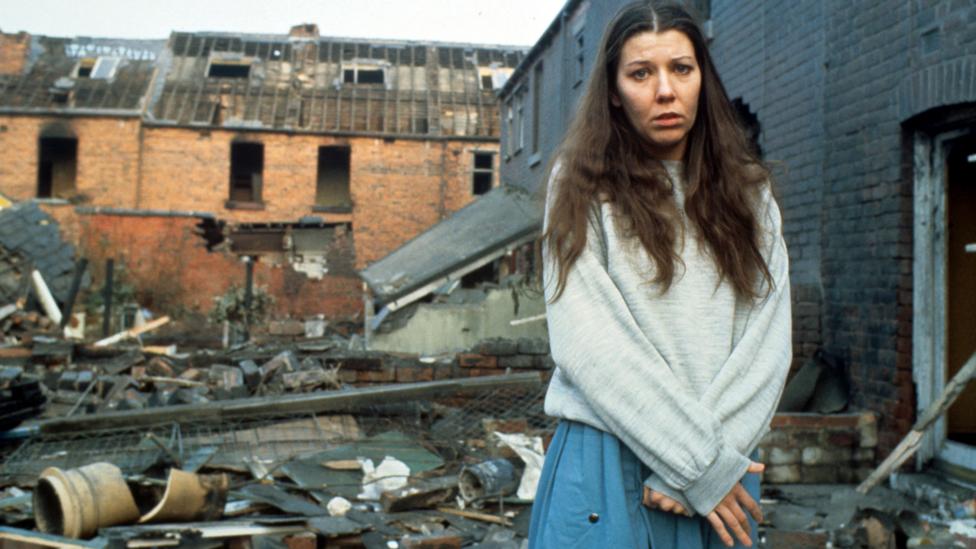
In the 1980s, a British TV drama called Threads told the story of two families living in Sheffield, during which time Britain is devastated by two nuclear attacks (Credit: BBC)
As he points out, the threat of nuclear war still exists. “I think we’re pretending it’s gone away, we think it won’t happen anymore,” says Tookey.
Although there are far fewer nuclear weapons in the world today than there were 30 years ago, several countries possess them. There are certainly enough to destroy the world a few times over, so they remain a continuing cause of existential uncertainty for the human race.
But it is fair to point out an inherent tension in PSM and other publications like it. On the one hand, it constantly urged readers to be optimistic about their chances of survival – should they prepare accordingly. However, that optimism chimed rather harshly with the bleak reality of nuclear apocalypse, often described in detail.
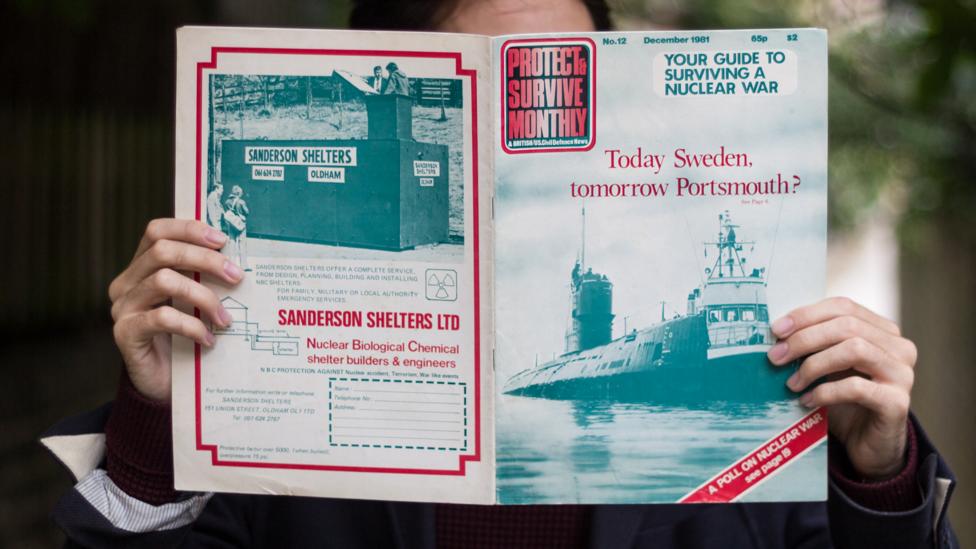
The magazine admired the civil defence preparation of other countries, such as Sweden (Credit: Javier Hirschfeld)
“It may be necessary to prepare defences against the unwelcome attentions of your neighbours,” read one article, before describing the process of obtaining a British firearms licence. Another feature, on how to manage food supplies, pointed out that one month after seeking refuge, shortages in even the best-stocked shelters would become apparent. But that would just have to be dealt with, as “the maintenance of law and order, burial of the dead, etc… will almost certainly take priority.”
If marauding neighbours, starvation and the putrefaction of family members’ corpses wasn’t harrowing enough, the magazine also obsessed over the threat posed by vermin and feral animals that were expected to roam the nuclear wasteland. “A wounded rat can be very dangerous and may attack while you are trying to reload,” explained one article. “If it is necessary to deal with a pack of rats help may be required.”
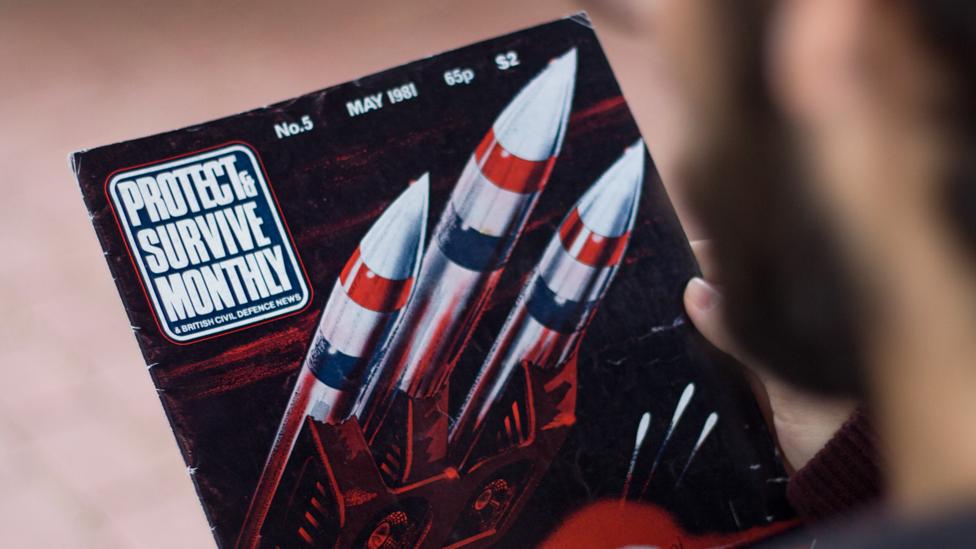
The magazine was optimistic about the chances of your survival in a nuclear attack - so long as you were prepared (Credit: Javier Hirschfeld)
Another feature even discussed the threat from escaped zoo animals. “Food will be one of their first priorities, whether it be farm animals or humans trapped in buildings or just the badly injured,” author Andrew Barnard wrote. “The smell of blood will not help matters.”
A Church of England vicar wrote for the magazine at least once. In his article he mused, 'Our current taboo against cannibalism may disappear'
A Church of England vicar also wrote for the magazine at least once. In his article he mused, “Our current taboo against cannibalism may disappear.”
“There is this mixture of optimism and pessimism in survivalist discourse,” says Preston. “In disasters and emergencies, people have an instinct that they would want to survive.” But this is tempered by human altruism: “No matter how bad things get, even in the worst wars, we’ve seen people wanting to help people out.”
Both Preston and Tookey think more could be done by the government to encourage civil defence planning today. But Preston acknowledges that few political parties are keen on boosting rhetoric around disaster and nuclear war as the political consequences would be “awful”.
But some nations do have information available. The US government publishes basic information on surviving a nuclear attack via the Department of Homeland Security, on its Ready.gov website.
And survivalism does seem to be in vogue again in some quarters. Protect & Survive Monthly may have long left the newsstand – but sadly the threat of nuclear war lives on.
https://www.bbc.com/future/article/...illing-magazine-for-nuclear-doomsday-preppers
In the 1980s, you could buy a publication offering detailed advice about how to prepare for nuclear war – it makes for timely, fascinating and occasionally morbid reading.
I
If you were to browse a British newsstand in the early 1980s, you might have discovered a rather unusual magazine.
Called Protect & Survive Monthly or “PSM”, it aimed to teach people how to survive the almost unthinkable – nuclear war.
“How many citizens would know what to do to protect their own lives and loved ones?,” wrote editor Colin Bruce Sibley in the maiden issue. And how many, he asked, would look dumbfounded to the skies, “waiting for a ‘convenient’ bomb to explode above their head and blast them into eternity?”

Building shelters was a common theme in the magazine - alongside vermin control (Credit: Javier Hirschfeld)
PSM’s name referenced a contemporaneous, but unconnected, government information campaign (Protect and Survive) to teach British citizens the basics of survival during nuclear Armageddon. The pamphlets and videos distributed by authorities are famous – but the similarly titled independent magazine has faded into obscurity.
In light of the nuclear threats coming out of the US and North Korea in recent weeks, reading the magazine in 2017 is an intriguing but chilling experience, including topics such as nuclear shelter contruction, the burial of loved ones, cannibalism, and even the difficulties of dealing with packs of wild rats.
READ MORE
- How prepared are we for the impact of nuclear war?
- The monster atomic bomb that was too big to use
- The secret nuclear bunker built as the UK's last hope

One family staged an experiment for the magazine to see if they could live in a shelter for an extended period (Credit: Javier Hirschfeld)
The magazine’s issues, many of which are retained at the British Library in London, present a very clear picture of what its makers thought the future looked like. A family dressed in protective suits and gas masks, outside an English country house, was featured on the cover of the first edition. A later issue showed a happy mother tending her baby – in a fallout shelter. And another presented huge missiles waiting to be launched somewhere in the middle of decimated nuclear waste. The surroundings are red and black. On the horizon, a mushroom cloud glows.
The sense that nuclear war wasn’t just a possibility, but practically imminent, is everywhere in the magazine. In the conclusion to that first editorial, editor Sibley writes, “if shelters are built now and Civil Defence techniques are learnt thoroughly, the aftermath death toll can be minimised” – as though the bombs were expected any moment.

Protect and Survive Monthly was published in the early 1980s (Credit: Javier Hirshfeld)
What, then, needed to be done? More than anything, there was an obsession over acquiring or building a fallout shelter for your home. Every edition of PSM featured reams of advertisements from British and international companies offering to construct such a shelter, or send one that could be buried in your garden and accessed through a small hatch.
A long-running feature of the magazine also told DIY-enthusiasts how to build their own. Fine details, such as the radiation shielding effectiveness of various materials, were included. Every 18mm (0.7in) of steel cut the radiation dose in half, one article explained, but you’d need 71mm (2.8in) of brickwork to achieve the same protection.
PSM once reported on a Cornish family’s two week experimental stay in their own fallout shelter – cut off from the outside world, role-playing a new life after the annihilation of civilisation. Robert and Margaret Farmer, along with their 11 year-old daughter Sarah, emerged triumphantly at the end of the experiment, which PSM described as a “complete success”. It did record, however, that “Sarah was a little bored around day three”.

Advertisements in the magazine included shelter-builders, seminars and even wine clubs (Credit: Javier Hirschfeld)
The magazine also kept track of projects up and down the country to erect refuges. A Welsh dairy farmer was reported to have spent the equivalent of £60,000 ($78,000) in today’s money on a safe haven for himself and his family. His next plan was to build a fallout shelter for his cows.
One advert even promoted a wine club, with vintages you could keep in your shelter
Many ingenious ideas were put forward – Tony Oldham, editor of British Caver magazine, suggested your local cave could make a handy refuge. Clean water might be collected as it dripped from stalactites, he explained.
Wherever readers planned to hide out, their safe space needed be stocked with useful items such as tools, fuel, first aid kits and Geiger counters, PSM advised. A month’s supply of food was also desirable. One advert even promoted a wine club, with vintages you could keep in your shelter. As one article put it, “You don’t want to be caught in a queue at the supermarket when the bomb drops!”
It was also important to acquire protective suits with gas masks that could reduce contamination from fallout – radioactive particles that spread into the environment after a nuclear detonation.
As the myriad options available were explained to readers each month, there were also regular referrals to the civil defence procedures that had been set up in other countries, including the Soviet Union, Sweden and Switzerland. PSM expressed a particular envy for the Swiss, 90% of whom, one issue claimed, had “immediate access” to a fallout shelter.

A shelter designed and built by the UK Home Office at the Home Defence College in York in 1980 (Credit: Imperial War Museum)
While it may seem to some as though the survivalists of the early 1980s were getting carried away with their provisions, recently declassified documents suggest a wide-scale nuclear war was closer at that time than perhaps any other. Encouraging the public to take the threat seriously might not have been so outlandish after all.
“It was a time of real threat,” explains John Preston at the University of East London, who has studied civil defence materials from the 1980s. “The superpowers were very much on a trigger.
“People were aware and worried about the threat of nuclear war – all the opinion surveys show that people thought it was a real possibility,” he adds.
I remember I had a fascination with it. My dad was obsessed with the idea of civil protection – Max Tookey, PSM reader
One PSM reader who still remembers the mood of the time is Max Tookey, now a lecturer in psychology at the University of Brighton. Aged 16, he wrote a letter to PSM that read, “Hastings, like a lot of towns in the South East, has a number of caves, old mines, and railway tunnels; why can’t local county councils convert these into mass shelters for the population?”
“I remember I had a fascination with it,” he recalls today. “My dad was obsessed with the idea of civil protection.”
As a teenager, Tookey had watched films like When the Wind Blows – an animated feature about an elderly British couple who survive the outbreak of nuclear war.
“If I remember rightly, with my school friends, we talked about what could happen quite a lot actually and this got me fired up,” he says.
Tookey, like many, still thinks that civil defence is neglected. He retains his old enthusiasm for caves being converted into fallout shelters – he suggests Chislehurst Caves in Kent, which were used as air raid shelters during World War Two.

In the 1980s, a British TV drama called Threads told the story of two families living in Sheffield, during which time Britain is devastated by two nuclear attacks (Credit: BBC)
As he points out, the threat of nuclear war still exists. “I think we’re pretending it’s gone away, we think it won’t happen anymore,” says Tookey.
Although there are far fewer nuclear weapons in the world today than there were 30 years ago, several countries possess them. There are certainly enough to destroy the world a few times over, so they remain a continuing cause of existential uncertainty for the human race.
But it is fair to point out an inherent tension in PSM and other publications like it. On the one hand, it constantly urged readers to be optimistic about their chances of survival – should they prepare accordingly. However, that optimism chimed rather harshly with the bleak reality of nuclear apocalypse, often described in detail.

The magazine admired the civil defence preparation of other countries, such as Sweden (Credit: Javier Hirschfeld)
“It may be necessary to prepare defences against the unwelcome attentions of your neighbours,” read one article, before describing the process of obtaining a British firearms licence. Another feature, on how to manage food supplies, pointed out that one month after seeking refuge, shortages in even the best-stocked shelters would become apparent. But that would just have to be dealt with, as “the maintenance of law and order, burial of the dead, etc… will almost certainly take priority.”
If marauding neighbours, starvation and the putrefaction of family members’ corpses wasn’t harrowing enough, the magazine also obsessed over the threat posed by vermin and feral animals that were expected to roam the nuclear wasteland. “A wounded rat can be very dangerous and may attack while you are trying to reload,” explained one article. “If it is necessary to deal with a pack of rats help may be required.”

The magazine was optimistic about the chances of your survival in a nuclear attack - so long as you were prepared (Credit: Javier Hirschfeld)
Another feature even discussed the threat from escaped zoo animals. “Food will be one of their first priorities, whether it be farm animals or humans trapped in buildings or just the badly injured,” author Andrew Barnard wrote. “The smell of blood will not help matters.”
A Church of England vicar wrote for the magazine at least once. In his article he mused, 'Our current taboo against cannibalism may disappear'
A Church of England vicar also wrote for the magazine at least once. In his article he mused, “Our current taboo against cannibalism may disappear.”
“There is this mixture of optimism and pessimism in survivalist discourse,” says Preston. “In disasters and emergencies, people have an instinct that they would want to survive.” But this is tempered by human altruism: “No matter how bad things get, even in the worst wars, we’ve seen people wanting to help people out.”
Both Preston and Tookey think more could be done by the government to encourage civil defence planning today. But Preston acknowledges that few political parties are keen on boosting rhetoric around disaster and nuclear war as the political consequences would be “awful”.
But some nations do have information available. The US government publishes basic information on surviving a nuclear attack via the Department of Homeland Security, on its Ready.gov website.
And survivalism does seem to be in vogue again in some quarters. Protect & Survive Monthly may have long left the newsstand – but sadly the threat of nuclear war lives on.
- Many thanks to Jacquelyn Arnold who kindly lent BBC Future the copies of PSM shown in the photos above.

















































